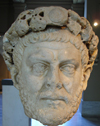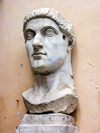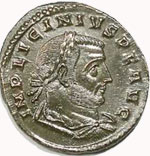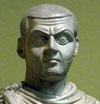COSTANTINO

Diocletianus |
The Diocletianus’ reform imposed that the Roman Empire was divided between two Augustus and two Caesar, designed by the Augustus as their successors. |
The two first Augustus were Diocletianus and Maximianus, who designed as Caesar Galerio and Costanzo Cloro
During 305 A.D. the two Augustus resigned in favour of the two Caesar.
Costanzo Cloro became Augustus for a short time: just an year later (306) he died in York, having designed as Ceasar Severo, but the Gallian army proclaimed Augustus Costantino, Costanzo Cloro’s natural son. At the same time in Rome Massenzio, Massimiano’s son, proclaimed himself not just Augustus but even Roman Emperor and governed Italy and the African province since 306 to 312.

Costantino |

Massenzio |
Obviously this situation caused a long period of civil wars till 324.
At the begining of this period the Roman Empire had four Augustus: Costantino who governed Gallia (France) and Spain, Licinio who had the power in Illiria (the actual Balcanic coast), Galerio and Massimino Daia who reigned in the eastern provinces and last but not least Massenzio.

Licinio |

Massimino Daia |
Galerio died in 311, so that the Augustus were only (!) three. Then Licinio who married Costanza, Costantino’s sister, and Masimino Daia agreed that Costantino had the mission to eliminate Massenzio.
The war of Costantino versus Massenzio had two main events: the battle of Verona, in the north east of Italy and close to Rome the battle of Ponte (bridge) Milvio (312), where Massenzio was defeated and died.
Anyway three Augustus were too many, the next step was the war between Licinio and Massimino Daia. Licinio won and Masimino Daia committed suicide (313).
Now the Augustus were two.
Licinio substained versus Costantino a first battle in 314 and lost his province of Illiria;
bad the first battle, worst the second (324): he lost his life.
At last Costantino remained the one Augustus and established himself in Bisanzio (Istambul), anyway after Diocleziano’s reform he divided the empire in four parts, named Eastern, Illiria, Italia, Gallia “prefetture” (that means an aggregation of provinces).
The following photos follow the history represented by the reliefs.
WEST SIDE (in the scheme number 1), Costantino’s army leaves from Milano
|
|
|
|
| The complete relief |
Details |
Details |
Details |
SOUTH FAÇADE (in the scheme number 5), the battle of Verona
|
|
|
|
| The complete relief |
Details |
Details |
Details |
SOUTH FAÇADE (in the scheme number 6), the battle of Ponte Milvio
|
|
|
|
| The complete relief |
Details |
Details |
Details |
EAST SIDE (in the scheme number 1), Costantino’s triumphal entrance in Rome
|
|
|
|
| The complete relief |
Details |
Details |
Details |
NORTH FAÇADE (in the scheme number 5), Costantino’s speech in the Foro
|
|
|
|
| The complete relief |
Details, on the left the Basilica Giulia, aside the arch of Tiberio |
Details, Costantino speech from the Rostra, behind the
tribune
the Diocleziano’s columns |
Details, the arch of
Settimio Severo |
NORTH FAÇADE (in the scheme number 6), congiarium (Costantino gives money to the people), in the forum of Caesar
|
|
|
|
| The complete relief |
Details |
Details |
Details |
As you can appreciate the Costanino relief is one of the most impressive representations of the Roman Forum, according to the fact that nowadays most of the monuments depicted in the relief disappeared or are hard to recognize.
back |

